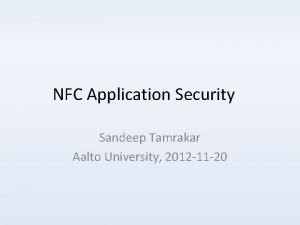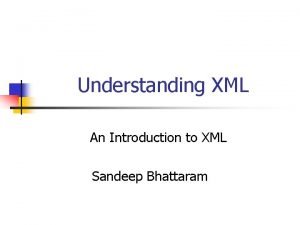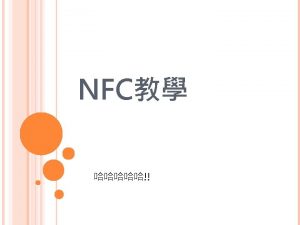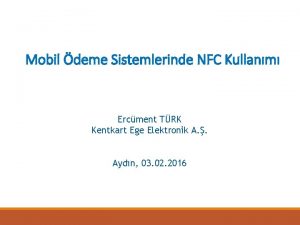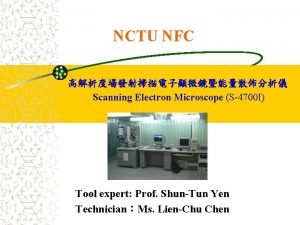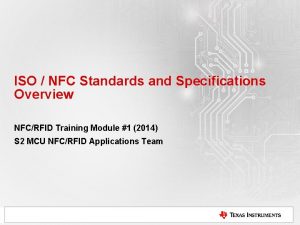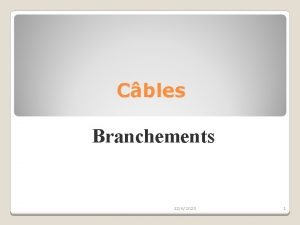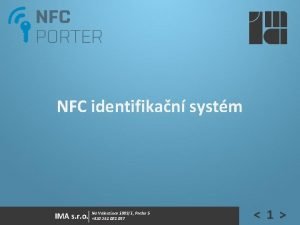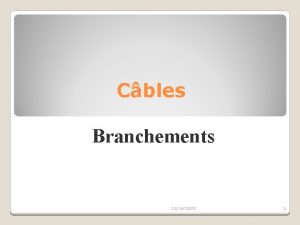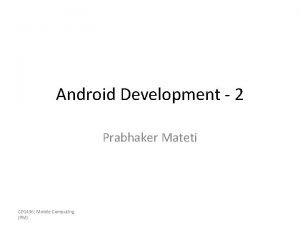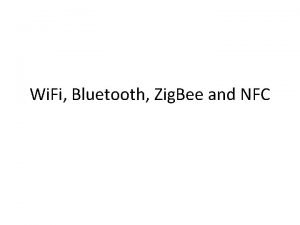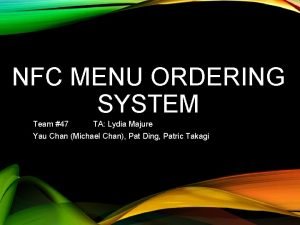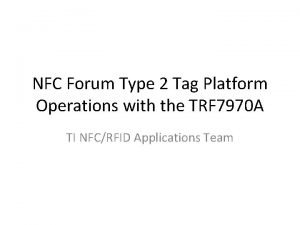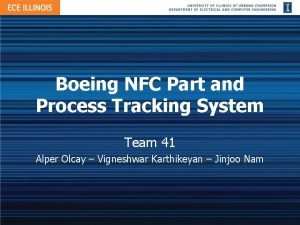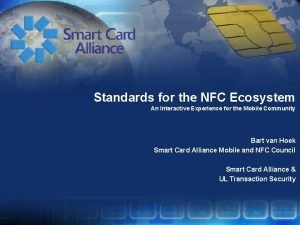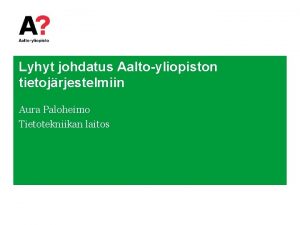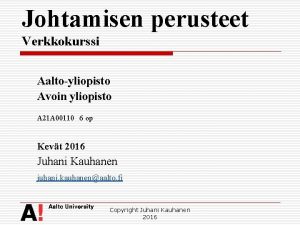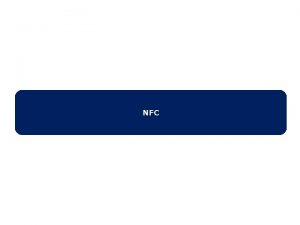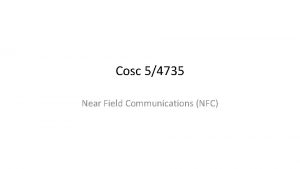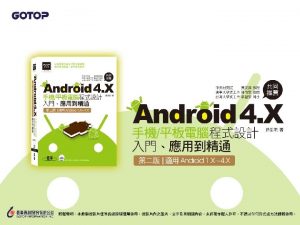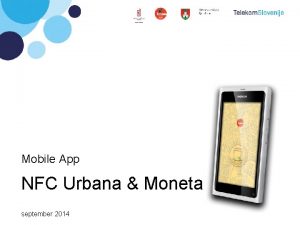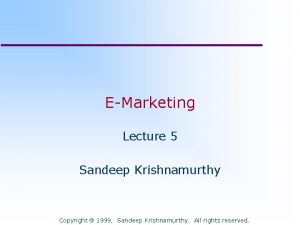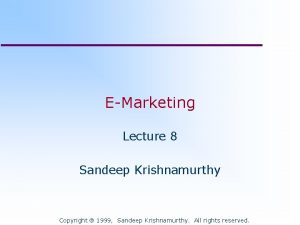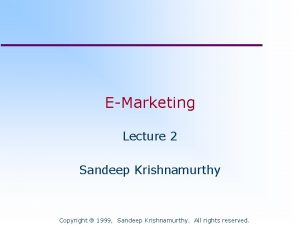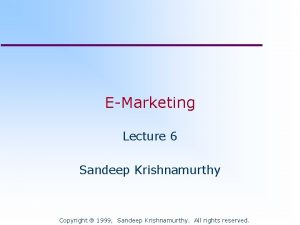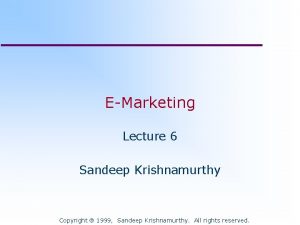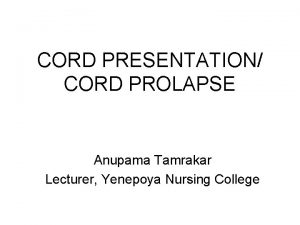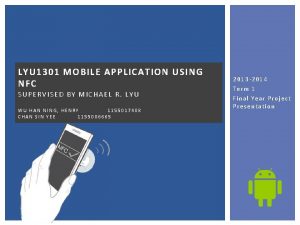NFC Application Security Sandeep Tamrakar Aalto University 2013








![MIFARE Ultralight with NDEF data # Memory content: [00] * 04: E 4: 91 MIFARE Ultralight with NDEF data # Memory content: [00] * 04: E 4: 91](https://slidetodoc.com/presentation_image_h/12687c886a7b565ea59a795aefd73917/image-9.jpg)




























- Slides: 37

NFC Application Security Sandeep Tamrakar Aalto University, 2013 -11 -21

NFC • Set of short-range, high frequency Radio Frequency Identity (RFID) data transmission standards – ISO 14443, ISO 15693, ISO 18092 • Operating distance: 4 cm to 10 cm • Operating Frequency: 13. 56 MHz • Data rates “of NFC radio”: 106 kbit/s, 212 kbit/s, 424 kbit/s • Communication between two devices: – Initiator: E. g. Reader – Target: E. g. Tag • NFC Forum defines: – Interoperability – NFC application specification

NFC data exchange principle • Active Device (reader) – Proximity coupling device (PCD) – Connected to power source – Generates an electromagnetic field for data exchange • Passive device (NFC tag) – Proximity integrated circuit card (PICC) – Harvest power from an Active device Source: Mifare® (14443 A) 13. 56 MHz RFID Proximity Antennas www. nxp. com/documents/application_note/AN 78010. pdf

Active NFC device modes of operation • Reader / Writer Mode (PCD, ISO 1443) – Active device that transmits power – Reads and modifies data stored in a passive tag – E. g. Mobile phone reading smart poster • Card Emulation Mode (PICC, ISO 14443) – Acts like a passive target – Interacts with an external active reader – E. g. Mobile phone used as a transport ticket, Google Wallet • Peer-to-peer Mode (ISO 18092) – Both the initiator and target transmit power – Establishes bi-directional data connection – E. g. A mobile phone exchanging a virtual business card with another mobile phone, Android Beam

NFC tags and smart cards • http: //open-nfc. org/documents/PRE_NFC_0804 -250%20 NFC%20 Standards. pdf

NFC forum tag types Type 1 Tags Type 2 Tags Type 3 Tags Type 4 Tags Unique Identity 4 or 7 bytes 8 bytes 7 bytes Transmission Protocol ISO 14443 A ISO 18092 ISO 14443 A Memory Size 96 bytes 64 bytes Variable sizes Memory Organization 12 blocks, each of 8 bytes 16 pages, each of 4 bytes Blocks, each of 16 bytes Smart card based. OTP bits 48 bits 32 bits Lock bits 16 bits Re-writable Until locked Pre-defined Issuer-defined Data collision protection No Yes Yes Transmission speed 106 kbits/s 212 kbits/s or 424 kbits/s 106 kbits/s, 212 kbits/s, 424 kbits/s Examples Topaz Ultralight Feli. Ca Lite Java cards, DESFire ( up to 2 KB) (up to 1 MB) (up to 32 KB)

Threats on memory tags • Tag cloning – E. g. Foursquare check-in tags can be cloned to falsely claim that you have been at the location (to claim loyalty discounts) – Can be prevented to some degree by calculating MAC that includes UID. • Modification of tag data – Can be prevented by locking tag re-write • Swapping / replacing valid tags – E. g. Tags used to help purchase items from vending machines can be swapped so that when a customer tries to purchase an item from a vending machine, the immoral person waiting at the other vending machine gets the purchased item.

Example: Security on Type 2 tag (MIFARE Ultralight) Page address • • Byte Numbers 00 h UID 0 UID 1 UID 2 BCC 0 01 h UID 3 UID 4 UID 5 UID 6 02 h BICC 1 INT LOCK 0 LOCK 1 03 h OTP 0 OTP 1 OTP 2 OTP 3 04 h Data 0 Data 1 Data 2 Data 3 05 h Data 4 Data 5 Data 6 Data 7 …. …. …. 0 Fh Data 44 Data 45 Data 46 Data 47 Bits 7 6 5 4 3 2 1 0 LOCK 0 L 7 L 6 L 5 L 4 L 3 BL 15 -10 BL 9 -4 BL OTP LOCK 1 L 15 L 14 L 13 L 12 L 11 L 10 L 9 L 8 Byte 0 – 9 : read only Byte 10 – 15: One time programmable (OTP) bytes; Once a bit in an OTP byte is set, it cannot be reset back. L : Lock page BL: Block, Once a BL bit is set the locking configuration for the corresponding page is unchangeable.
![MIFARE Ultralight with NDEF data Memory content 00 04 E 4 91 MIFARE Ultralight with NDEF data # Memory content: [00] * 04: E 4: 91](https://slidetodoc.com/presentation_image_h/12687c886a7b565ea59a795aefd73917/image-9.jpg)
MIFARE Ultralight with NDEF data # Memory content: [00] * 04: E 4: 91 F 9 (UID 0 -UID 2, BCC 0) [01] * CA: 1 A: 26: 80 (UID 3 -UID 6) [02]. 76 48 00 00 (BCC 1, INT, LOCK 0 -LOCK 1) [03]. E 1: 10: 06: 00 (OTP 0 -OTP 3) [04]. 03 0 D D 1 01 |. . | [05]. 09 55 01 61 |. U. a| [06]. 61 6 C 74 6 F |alto| [07]. 2 E 66 69 FE |. fi. | [08]. 00 00 |. . | [09]. 00 00 |. . | [0 A]. 00 00 |. . | [0 B]. 00 00 |. . | [0 C]. 00 00 |. . | [0 D]. 00 00 |. . | [0 E]. 00 00 |. . | [0 F]. 00 00 00 03 |. . | *: locked & blocked, . : un(b)locked OTP data E 1: 10: 06: 00 defines NDEF application For detail on NDEF format, see NFC forum NFC Data Exchange Format (NDEF) Technical specification

NFC tag security • Security mechanisms: – 7 -byte Unique Identity (UID) – One-time programmable bits: bits that can be set to one but not reset to zero • can be used as counter – Pages can be locked to prevent modification • Security assumptions: – The UID cannot be cloned or spoofed !!!? – When reading the tag, the UID and card content cannot be modified by the attacker (physical session integrity) !!!? – Attacker can freely write data to the card, and interrupt sessions (tear card away from the reader)

No Cryptographic security included in the NFC Specs • NFC transmission protocols do not define any specific encryption or security mechanism – ISO 14443 : Read/Write and Card Emulation mode – ISO 18092: Peer-to-peer mode • NDEF specification defines signature scheme for integrity protection – Does not prevents content cloning (signature does not cover the card UID) – Does not include reader authentication for access control • Therefore, cryptographic security must be defined by the NFC application.

Contactless smart cards • Memory tags with some security functionality – MIFARE Ultralight: UID, lock bytes, OTP – Ultralight C: triple-DES authentication – DESFire: Triple-DES / AES mutual authentication, file system with access control lists • Smart cards with contactless interface – CPU and operating system – Tamper-resistant environment – Secure crypto-processor – Secure file system – E. g. Java. Card, EMV contactless debit and credit cards • Distinction between memory cards and smart cards is not always clear cut

Relay Attack on NFC • Relaying e. g. contactless EMV payments from your pocket to a faraway shop – Requires card emulation on the proxy token – Does not require UID spoofing because EMV does not use the UID Source: L. Francis, G. P. Hancke, K. E. Mayes, and K. Markantonakis. Practical Relay Attack on Contactless Transactions by Using NFC Mobile Phones. Cryptology e. Print Archive, Report 2011/618, 2011. http: //eprint. iacr. org/2011/618.

Frame Waiting Time (FWT) Frame sent by PCD Frame sent by PICC t < FWT Time

NFC reader and tag interaction PCD REQA ATQA Anti-collision loop UID + SAK Request for Answer to Select (RATS) Answer To Select (ATS). . . Command APDU Response APDU PICC

FWT parameter Answer To Select (ATS) TL Length Byte T 0 Format Byte TA TB Tk FWI SFGI Interface Bytes FWI: Frame Waiting Time Integer SFGI: Start-up Frame Guard Time Historical Bytes (ISO/IEC 7816 -4) FWT = (256 X 16 / fc) X 2 FWI TC T 1 TB CRC 1 CRC 2 FWTMin = 0: (256 X 16/ 13. 56 X 106) X 1 ≈ 303 μs FWT = 4: (256 X 16/ 13. 56 X 106) X 24 ≈ 4833 μs FWT = 8: (256 X 16/ 13. 56 X 106) X 28 ≈ 77 ms FWTMax = 14: (256 X 16/ 13. 56 X 106) X 214 ≈ 4949 ms

Observation on Android Jelly Bean (4. 1. 2) • MIFARE DESFire: – default FWI = 0 x 8 – FWT = 77 ms • Nexus S responded well beyond 77 ms (≈430 ms) • Changing FWI parameter doesn’t affect response time • We assume fixed FWT implementation • Max. latency for relay attack on Nexus S NFC reader is around 430 ms

NFC on mobile phones • Integration of NFC in mobile phone is growing – Nokia Lumia 610 and above – Nexus S and above – Samsung Galaxy S II plus and above – Black. Berry 10 – Many more

NFC support on phones • Mostly Read/write and P 2 P mode • Card Emulation is usually restricted • Some phone platform include Secure Element necessary for Card Emulation however public APIs are restricted • Currently used applications – NDEF tag read/write • Four. Square check-ins • Samsung Tect. Tiles • Potential NFC applications: – Public transit tickets – Mobile payment – Loyalty card

Threats on NFC phones • Denial of Service attacks – Mobile phone NFC stack reacts to any tag within its NFC range – Some mal-formatted tags can jam the stack – Also, most of the card manager in SE blocks itself after 10 successive authentication failures • Malware delivery via NFC – Mobile OSs reads NDEF message and opens corresponding application • E. g. NDEF with URL causes phone to open the URL in its default web browser – NDEF with URL to malware download page – NFC message with malicious content • Malicious file over NFC to exploit android document viewer vulnerability [1] • NFC to execute Unstructured Supplementary Service Data (USSD) codes [2] 1. 2. https: //www. hkcert. org/my_url/en/blog/12092801 http: //www. zdnet. com/exploit-beamed-via-nfc-to-hack-samsung-galaxy-s 3 -android-4 -0 -4 -7000004510/

NFC based financial application on phone • Rely on security offered by the mobile phone platform – Sandboxes – Permission based access control • Should protect against mobile malwares • Ill intent of the phone user – E. g. User may gain root access to modify ticket value • Protect against remote and local attacker • Ensure the security even when the OS is compromised

Secure execution on mobile phone • Isolate Execution – Execution of a security-sensitive code in complete isolation from other codes – Ensures integrity and run-time secrecy of application data • Secure Storage – Protects stored data from unauthorized access • Passwords, secret keys, credentials etc. • Remote Attestation – Remotely verify authenticity of any particular application before interaction – Root of trust measurement – Dynamic root of trust measurement (DRTM) • Secure Provisioning – Securely deploying application module to a specific user device from a remote server over the air – Application migration from one device to another • Trusted path – Ensures unaltered communication channel between the end points – Direct physical connection between NFC front end controller and the isolated execution environment

Available Secure Elements • Contactless stickers – Independent of the mobile phone OS • Elisa Lompakko • Universal Integrated Circuit Card (UICC) – Preferred by Mobile Network Operators • Orange Quick Tap • Secure Micro. SD – Used by some banks in Taiwan • Embedded Secure Element – Google Wallet • Programmable Trusted Execution Environment – On-board Credential (Ob. C) – Mobicore

Security Element Architecture, e. g. SIM Issuer Security Domain Credit card Applet Application Firewall SIM applet Application Firewall Issuer Security Domain Third Party Security Domain Public-transport ticket Card Manager • SIM is multi-application smart card • Each service provider creates a separate Security Domain on the card • Problems: increases the complexity of card manager; no support for over-the-air installation of new applets

Trusted Service Manager (TSM) Mobile Network Operator (MNO) Service Providers Bank Public-transit Authority TSM Loyalty … μSD Model currently favored by network operators: • Single trusted entity serving both MNO and Service Providers • Securely distributes and personalize the SP application to the customer’s SE over the air (OTA personalization). • Verify user’s device and SE capabilities and resources • Manage life cycle of the applications Embedded SE SIM

NFC applications

NFC Data Exchange Format (NDEF) NDEF Message NDEF Record Header Payload • NDEF is Message encapsulation format. • Used to exchange messages between: • NFC devices or • An NFC device and a tag. • Contains one or more NFC application data as NDEF Record • Header defines the properties of the Payload. • Start and end of NDEF records • Record type definition (RTD): payload data type • Length of the payload etc. NDEF Record

Signature Record Type Definition NDEF Record 1 NDEF Record 2 Signed records Empty NDEF Signature Record 1 Signature for record 1&2 NDEF Record 3 Signed record • Provides integrity and authenticity • Signature RTD contains: – Signature, • RSA (1024) with SHA-1 and PKCS#1 v 1. 5 padding or PSS • ECDSA (P-192) with SHA-1 with no padding. – Certificate chain. – Or, reference location to the signature • Signature Record apply for – all preceding records, (from record 1) or, – Record following the preceding Signature record. • Vulnerability – Cloning, replacing a tag with another valid tag NDEF Signature Record 2 Signature only for record 3

Tag UID based NFC applications • Simple Access control application based on tag UID – NFC tags is used as credential to identify the user – Reader must be connected to a backend database – Backend server maintains access policies • Pros: – Simple and cheap solution • “UID cannot be faked easily” – Suitable for small scale business • Cons: – Backend complexity increases with the number of customers – Readers needs to be connected to the backend server all the time.

Event Ticketing • One time or limited use tags – MIFARE Ultralight • Reader implements cryptographic functionality – Key diversification – e. g. Hash(UID + Master key) – Encrypts data and store the cipher-text on tags. – Reads the cipher-text from tags and decrypts data. • Use of OTP bytes as incremental counter • Use Lock bytes to prevent rewrite • MAC for integrity protection

Public transit application • Proprietary solutions are widely used – MIFARE Classic – MIFARE DESFire EV 1 – Uses Symmetric crypto • Triple-DES, AES – Value is stored on the card • Standards – ITSO: Interoperable public transport ticketing using contactless smart customer media.

Open Payment Ticketing • Smart Card Alliance proposal for NFC ticketing • Each traveler has a travel account in a server cloud, which is operated by a service provider (SP) • Travel card only stores user’s identity and credentials 1. User identity is verified by a reader at the station gate 2. Ticket identity and travel information sent to a backend server 3. The backend server calculates the ticket fare and forwards the information to SP for payment collection 4. Payment is collected by SP • Allows credentials from different SPs to be used – E. g. Bank cards, SIM card, National ID etc.

Open Payment Ticketing with Mobile Phone Fare Calculation Service Provider (accounting authority) Transport Authority NFC • Transport Authority • Operates transport system • Calculate the fare calculation based on the ID and traveling distance • Collects ticketing evidence for auditing • Service provider (e. g. bank or mobile operator) • Manages the customer relationship and travel account; issues the travel credentials • Collects evidence directly from phones and from Transport Authority for auditing • Collets payment from the customer (prepaid or credit)

Identity Verification in Open Payment Device Reader Challenge || IDR Cert. D (PKD || IDD||…) Fresh Token Sig. D[Challenge ||IDD||IDR] MACK [Challenge || IDD||IDR] Challenge-response protocol: • User Verification at the gate • Exchange of data > 1 KB • Authentication time is around 1 sec with current NFC data speed Faster secret-key protocol: • Reader and SP share a secret key • Phone fetches fresh token from SP over the Internet before traveling • Reader verifies the fresh token with its key • Exchange of data < 100 B • MAC verification by SP for additional auditing; not done in real time

Mobile NFC Payment: Google Wallet First Generation Google Wallet (no longer in use) • Secure Element in the phone stores credit-card information – Embedded secure element on PN 65 NFC board in Google phones – Can store more than one credit card • Mobile phone acts as a credit card when presented to a payment terminal – NFC card emulation mode • Payment protocol is controlled by wallet applet running inside the secure element • Application running in user space provides interfaces for – PIN entry, selection of credit card, displaying payment information • Google acted as the TSM and distributed credit card applets to the phones

Mobile NFC Payment: Google Wallet Second Generation Google Wallet • User’s credit card or bank account information is stored by Google in the cloud • Secure element on the phone stores a virtual payment card identity 1. During payment, user selects payment card or bank from the application on his phone 2. The virtual card is presented to the point-of-sale terminal 3. Google collects the payment from user’s credit card or bank account and makes the payment to the merchant • Payment terminal needs to be modified to support this service

Additional reading • NFC Data Exchange Format (NDEF) Technical Specification • Madlmayr, G. ; Langer, J. ; Kantner, C. ; Scharinger, J. ; , "NFC Devices: Security and Privacy, " Availability, Reliability and Security, 2008. ARES 08. Third International Conference on , vol. , no. , pp. 642 -647, 4 -7 March 2008 doi: 10. 1109/ARES. 2008. 105 • L. Francis, G. P. Hancke, K. E. Mayes, and K. Markantonakis. Practical Relay Attack on Contactless Transactions by Using NFC Mobile Phones. Cryptology e. Print Archive, Report 2011/618, 2011. http: //eprint. iacr. org/2011/618.
 Nfc tag type
Nfc tag type Amit tamrakar
Amit tamrakar Aalto university school of engineering
Aalto university school of engineering Aalto mikkeli
Aalto mikkeli Aalto university mikkeli
Aalto university mikkeli Provate security
Provate security Sandeep singh jolly
Sandeep singh jolly Sandeep bhattaram
Sandeep bhattaram Sandeep somaiya
Sandeep somaiya Sandeep chinchali
Sandeep chinchali Dr sandeep walia
Dr sandeep walia Sandeep sahany
Sandeep sahany Petrolera zuata
Petrolera zuata Dean deakin
Dean deakin Sick sinus syndrome ecg criteria
Sick sinus syndrome ecg criteria Sandeep mallipattu
Sandeep mallipattu Gampa sandeep
Gampa sandeep Dr sandeep sekhon
Dr sandeep sekhon Sandeep modhvadia
Sandeep modhvadia Sandeep modhvadia
Sandeep modhvadia Sandeep baruah
Sandeep baruah Sandeep rajan md
Sandeep rajan md Action_tech_discovered
Action_tech_discovered Nfc kentkart
Nfc kentkart Electron nfc
Electron nfc Nfc iso standards
Nfc iso standards Cable nfc 33-210
Cable nfc 33-210 Nfc adalah
Nfc adalah Nf c 33-210
Nf c 33-210 Ceg vs nfc
Ceg vs nfc Zig wireless
Zig wireless Lydia nfc
Lydia nfc Nfc forum type 2 tag specification
Nfc forum type 2 tag specification Nfc online
Nfc online Usda nfc dprs
Usda nfc dprs Uicc iso device
Uicc iso device Aalto eduroam
Aalto eduroam Aalto yliopisto johtaminen
Aalto yliopisto johtaminen
